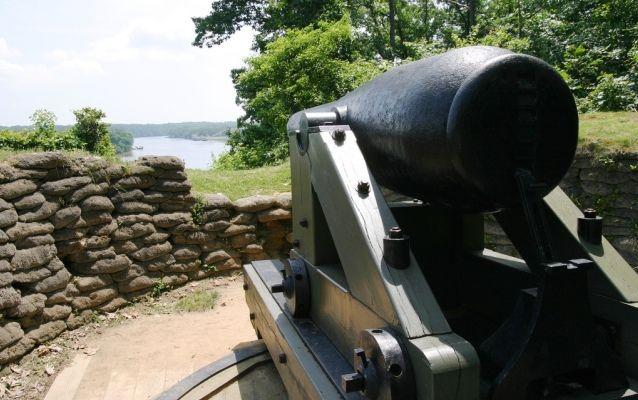Last updated: March 12, 2015
Place
Drewry's Bluff

Civil War Trust
As capital of the Confederacy, Richmond, Virginia, was a constant target of northern armies. The city, however, was vulnerable by water as well as by land. Gunboats could navigate the James River all the way to Richmond. The key to the city's river defenses lay in a small fort only seven miles south of the capital. Known throughout the south as Drewry's Bluff (after local landowner Captain Augustus H. Drewry), northern troops referred to it as Fort Darling.
Drewry's Bluff rose 90 feet above the water and commanded a sharp bend in the James River, making it a logical site for a defensive position. On March 17,1862, Captain Drewry's Southside Artillery began constructing earthworks, erecting barracks, digging artillery emplacements, and mounting three large seacoast guns (one 10-inch Columbiad and two 8-inch Columbiads) in the fort.
After the C.S.S. Virginia was scuttled on May 11, 1862, her crew joined the defenses at Drewry's Bluff. Commander Ebeneezer Farrand supervised the defenses of the fort and had numerous ships sunk as obstructions in the river beneath the bluff. Six more large guns occupied pits just upriver from the fort. Men worked around the clock to ensure the defenses would be ready when the Union fleet arrived.
The Federal squadron steamed around the bend in the river below Drewry's Bluff on the morning of May 15. The force, under Commander John Rodgers, consisted of five ships, including two inronclads (the famed Monitor and Galena) and three gunboats (Port Royal, Aroostook, and Naugatuck). At 7:15 a.m. the Galena opened fire on the fort, sending three giant projectiles toward the Confederate position.
The five Union ships anchored in the river below the fort. When Confederate batteries in the fort replied, the whole vicinity shook with the concussion of the big guns. Southern infantry lined the banks of the river to harass the sailors. On the Monitor, the rifle balls of the sharpshooters "pattered upon the decks like rain."
After four long hours of exchanging fire, the "perfect tornado of shot and shell" ended. With his ammunition nearly depleted, Commander Rodgers gave the signal to discontinue the action at 11:30 am. His force suffered at least 14 dead and 13 wounded, while the Confederates admitted to 7 killed and 8 wounded. A visitor wrote that the Galena "looked like a slaughterhouse" after the battle. The fort on Drewry's Bluff had blunted the Union advance just seven miles short of the Confederate capital. Richmond remained safe.
